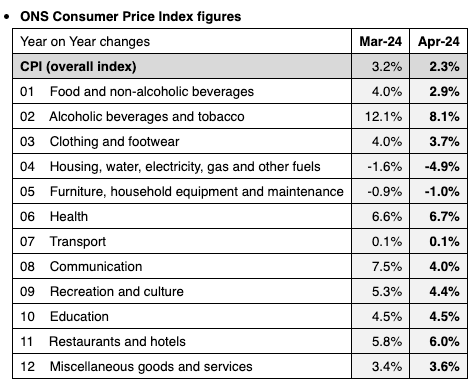Pound Sterling Jumps against Euro, Dollar After UK Inflation Beats Expectations
- Written by: Gary Howes

Image © Adobe Stock
The Pound to Euro exchange rate powered to its highest level since March at 1.1736 after UK inflation fell to 2.3% year-on-year in April, a figure that was higher than the market and the Bank of England were expecting (2.1%).
The all-important and much-watched services inflation component of the release was notably hotter than expected at 5.9%, whereas the market and Bank of England were expecting a reading of 5.5%.
The odds of an interest rate cut at the Bank of England in June are now materially lower than 50%, having been close to 60% just days earlier. The rise in the value of the Pound reflects this readjustment in expectations for Bank of England policy.
The Pound rose against all its peers in the G10 in the wake of the release, with the Pound to Dollar exchange rate hitting 1.2745, its highest level since March 21. "The market reacted to the news. Sterling rose against the dollar to a peak of $1.2759, from $1.2707, before edging back to $1.2735. Markets now aren’t pricing in a full cut until November, from August previously," says Gabriella Dickens, G7 economist at AXA Investment Managers.
Compare Currency Exchange Rates
Find out how much you could save on your international transfer
Estimated saving compared to high street banks:
£25.00
Free • No obligation • Takes 2 minutes
Those who read Pound Sterling Live's recent article covering the views of Andrew Sentance that warned of an upside shock will have been prepared for the eventuality of an upside surprise. "My forecast for core inflation and services inflation were broadly correct. I forecast core inflation at 3.8% - the actual figure was 3.9%. My forecast for services was 6% vs 5.9% actual. Measures of underlying inflation have turned out much higher than market consensus," says Sentance following the release.
The outcome meanwhile lowers the tail risk for the Pound of a brace of back-to-back rate cuts in the summer. "Does the Central Bank cut in June, or take advantage of the fact inflation came in a touch higher than expected and hold off until its August meeting? Movements in currency markets this morning suggest an August cut just became a little more likely," says Nicholas Hyett, Investment Manager at Wealth Club.
"UK inflation at 2.3% now undershooting the G20 average - which it will for the rest of the summer - but the symbolism of being above 2% will delay some of the more shrill political calls for cuts for a month or two," says Simon French, an economist at Panmure Gordon.
Above: GBP has hit new multi-week highs against the Dollar and Euro. Track GBP/AUD with your own custom rate alerts. Set Up Here
He explains that services inflation at 5.9% is the most consequential aspect of the report as it proves non-tradeable components are proving more sticky than hoped. "We will stick to August for the first rate cut - although another round of wages and prices data to come before June MPC," says French.
"Today’s release was a bit of a blow for the BoE and the Prime Minister," says Paul Dales, Chief UK Economist at Capital Economics. "Even though there is still a wages and a CPI release to go before the BoE meeting on 20th June, it feels as though a cut then now seems very unlikely. Even a cut in August is looking a bit more doubtful."
Looking at the details, it was the fall in household energy bills in April that provided the most significant downward impulse in inflation. Falling food prices also weighed. There were also notable falls in the inflation rate of clothing and footwear and alcoholic beverages.
Image courtesy of the BRC.
As the above chart shows, service-oriented industries such as restaurants and hotels continue to push prices higher. This will reflect the heavy wage costs such industries face and emphasises inflation will only return to the 2.0% target on a sustainable basis if wages cool.






